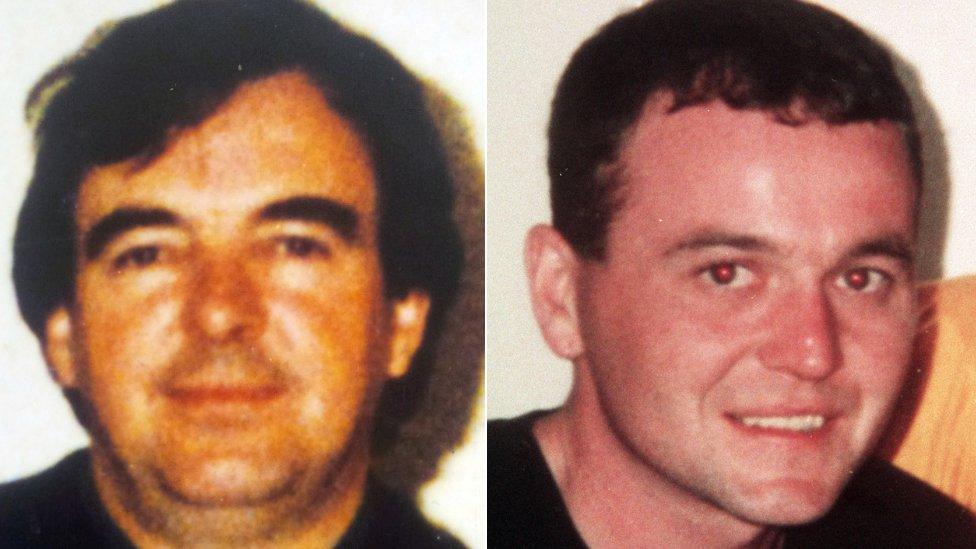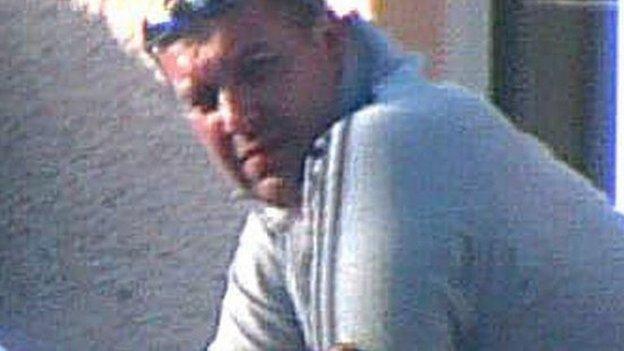UVF double-murder accused was excited after shooting, court told
- Published

Eamon Fox, 44, and Gary Convie, 24, were shot dead in 1994
A north Belfast man accused of the 1994 murders of two Catholic workmen was "excited, hyperactive and pleased" after the shooting, a court has heard.
Eamon Fox, 41, and Gary Convie, 24, were shot dead on a building site.
A lawyer said much of the evidence against James Stewart Smyth of Forthriver Link came from Ulster Volunteer Force (UVF) commander turned supergrass Gary Haggarty.
Mr Smyth, who is 57, denies killing the men.
As the prosecution opened its case against Mr Smyth, a crown barrister told the judge the accused "mowed down two totally innocent men in cold blood in broad daylight doing a decent day's work in the name of the UVF and naked sectarianism".
Mr Smyth faces five charges arising from the killings in North Queen Street in Belfast.
He denies the murders of father-of-one Mr Convie and father-of-six Mr Fox on 17 May 1994 as well as the attempted murder of a third workman on the same date.
He also denies possessing a Sten submachine gun and a quantity of ammunition with intent, and of being a member of the UVF.
Belfast Crown Court heard Mr Convie and Mr Fox died in a hail of bullets fired by a gunman standing in an adjacent children's playground.
Prior to the shooting, a hole had been cut in a fence which gave access to the gunman, who was seen fleeing across the playground after the shooting and who was heard shouting "Up the UVF".

Gary Haggarty, the most senior loyalist paramilitary to become a supergrass, is to be a prosecution witness in the trial
Other witnesses recalled seeing a man dressed in dark clothing and a dark hat or hood firing shots at the car from the fence area before fleeing.
This man, the prosecution argues, was Mr Smyth.
A Crown prosecutor said this was based both on DNA evidence and the evidence of Mr Haggarty.
'Jimmy Shades'
Revealing Haggarty would be giving evidence during the non-jury trial, the prosecutor said that while he had committed multiple murders and a catalogue of other offences, he was nonetheless a "credible witness."
The court heard Mr Haggarty joined the UVF in January 1991 and was recruited by police Special Branch in 1993.
Haggarty told police that Mr Smyth - who had the nickname Jimmy Shades - was the gunman and he acted on the orders of Mark Haddock.
He said that in May 1994 he was asked by Mr Haddock to store weapons, which included the Sten sub machine gun used in the double murder and a Barbour jacket belonging to Mr Haddock which the Crown said was worn by Mr Smyth on the day of the murders.
The prosecutor said a holdall containing the gun, jacket and other items was located in a derelict house in Alexander Park Avenue in the days after the killing after information on their whereabouts was provided by Haggarty.
He added that when the jacket was forensically tested, Smyth's DNA was located on the inside of the coat.
Haggarty told police that after the killing Mr Smyth was driven away in a waiting vehicle to a safe house.
'Really pleased'
Haggarty also said that when he met Mr Smyth later that night in a pub, Mr Smyth was "excited, hyperactive and really pleased" and that he said "it was a full clip and I emptied it until it stopped firing".
In March 1995 a man was convicted of aiding and abetting the murders of Mr Convie and Mr Fox.
Following information supplied by Haggarty, Mr Smyth was arrested in March 2013 and was interviewed 12 times.
He told police: "I know nothing about these murders, I'm definitely not guilty."
He refused to answer any more questions.
He gave no response to questions including why his DNA was found on the inside of the Barbour jacket which was found along with the murder weapon.
The prosecutor said Haggarty had "admitted his own guilt in relation to the murders of Mr Convie and Mr Fox" which included both storing and test firing the murder weapon prior to the shooting as well as being close to the scene of the double murder.
He told the senior judge there would be "other evidence" presented during the trial that would "support Haggarty's evidence" against Smyth.